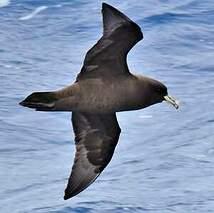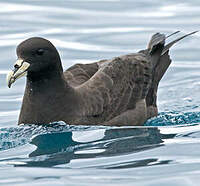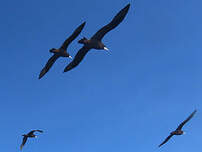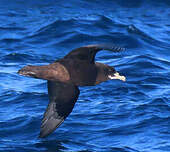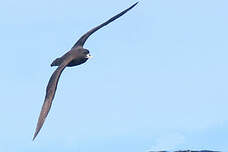White-chinned Petrel
Procellaria aequinoctialis - Puffin à menton blanc
Identification
One of the most difficult species to identify. Entirely black, except for a small (sometimes very small!) white patch on the chin. Can be confused with the Westland Petrel (P. westlandica) and Parkinson's Petrel (P. parkinsoni) with which it is sometimes seen. It is clearly larger than the other two species, but this is not very meaningful when they are not seen together. The best criterion is the colour of the bill, horn-coloured, while the others have a black tip. It is generally found further south than its two congeners.
Subspecific information 2 subspecies
- Procellaria aequinoctialis aequinoctialis (widespread)
- Procellaria aequinoctialis steadi ()
Foreign names
- Puffin à menton blanc,
- Pardela gorjiblanca,
- pardela-de-mento-branco,
- Weißkinn-Sturmvogel,
- fehérállú viharmadár,
- Witkinstormvogel,
- Petrello mentobianco,
- vithakad petrell,
- Hvithakepetrell,
- víchrovník bielobradý,
- buřňák bělobradý,
- Hvidhaget Skråpe,
- isomeriliitäjä,
- Bassiaan (Witkenpylstormvoël),
- baldriga de mentó blanc,
- burzyk białobrody,
- Белогорлый буревестник,
- ノドジロクロミズナギドリ,
- 白颏风鹱,
- vithakad petrell,
- 白頦風鸌,
Habitat
Behaviour character trait
Flight
Dietfeeding habits
During the breeding season, their main prey is cephalopods, with some crustaceans as well. Out of breeding season, fish and waste from fishing boats become especially important. Although they mostly catch prey at the surface, they can also dive, either from the surface or while flying, to catch food.
Reproduction nesting
Geographic range
The White-chinned Petrel breeds on several subantarctic islands off New Zealand, Africa and South America; for example the French territories of Marion, Crozet and the Kerguelen Islands, as well as on the Falklands, Prince Edward, Auckland and Campbell Islands. It can be observed in an area extending up to 65° south, but like several other procellariiform species, it takes advantage of the Humboldt Current to travel almost as far north as the equator along the western coasts of South America.
Threats - protection
IUCN conservation status
concern
in the Wild
threatened
evaluated
The population is strong with several million individuals (2,000,000 nesting pairs just in South Georgia). The main threats are predators introduced on the islands where it reproduces and, like on Tristan da Cunha, the consumption of chicks by the inhabitants. It is likely that its disappearance from the Chatham Islands is due to its exploitation by humans. Mortality due to industrial fishing activities is important.
Sources of information
- IOC World Bird List (v15.1), Gill, F and D Donsker (Eds). 2025-12-07.
- Albatrosses, Petrels and Shearwaters of the World, Onley Derek et Scofield Paul
- Field Guide to New Zealand Seabirds, Parkinson Brian
- Seabirds, an identification guide, Harrison Peter
- The hand guide to the birds of New Zealand, Robertson Hugh et Heather Barrie
- Vol. 1 - Handbook of the Birds of the World, Josep del Hoyo-Andrew Elliot-Jordi Sargatal
- Avibase, Lepage Denis
- BirdLife International, BirdLife International
Other sources of interest
 Specification sheet created on
30/07/2023 by Georges Olioso
Specification sheet created on
30/07/2023 by Georges OliosoTranslation by AI Oiseaux.net
© 1996-2025 Oiseaux.net
- Accipitriformes
- Aegotheliformes
- Anseriformes
- Apodiformes
- Apterygiformes
- Bucerotiformes
- Caprimulgiformes
- Cariamiformes
- Casuariiformes
- Charadriiformes
- Ciconiiformes
- Coliiformes
- Columbiformes
- Coraciiformes
- Cuculiformes
- Eurypygiformes
- Falconiformes
- Galliformes
- Gaviiformes
- Gruiformes
- Leptosomiformes
- Mesitornithiformes
- Musophagiformes
- Nyctibiiformes
- Opisthocomiformes
- Otidiformes
- Passeriformes
- Pelecaniformes
- Phaethontiformes
- Phoenicopteriformes
- Piciformes
- Podargiformes
- Podicipediformes
- Procellariiformes
- Psittaciformes
- Pterocliformes
- Rheiformes
- Sphenisciformes
- Steatornithiformes
- Strigiformes
- Struthioniformes
- Suliformes
- Tinamiformes
- Trogoniformes





